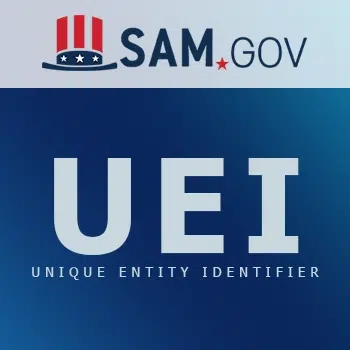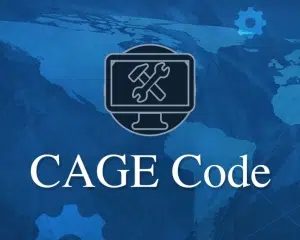UEI vs. CAGE Code
Understanding the Key Differences
Federal contracting can be a labyrinth of complex processes, regulations, and requirements. For businesses aiming to work with the U.S. government, understanding key identifiers like the Unique Entity Identifier (UEI) and the Commercial and Government Entity (CAGE) Code is essential. These codes play an important role in identifying businesses and streamlining federal procurement.
If you’re new to contracting with the U.S. government or unsure about the differences between these two identifiers, the experts at the Federal Contracting Center have got you covered. This blog post will explain what UEIs and CAGE Codes are, how they differ, the steps to obtain them, and why they remain critically important in 2025.
What Is the Unique Entity Identifier (UEI)?

Key Characteristics of the UEI
- Universal Use: The UEI acts as the definitive identifier for any entity conducting business with the federal government.
- Random Assignment: Each UEI is unique and randomly generated, minimizing the chance of duplication.
- Managed in SAM: The System for Award Management (SAM) assigns, manages, and maintains all UEIs, making it a one-stop shop for federal registration.
Whether your organization is bidding for government contracts, receiving grants, or engaging in subcontracting work, a UEI validates your business and creates a record of your eligibility for federal engagements.
What Is a CAGE Code?
A Commercial and Government Entity (CAGE) Code is a five-character alphanumeric code used to identify a business’s physical location. Unlike the UEI, which is a universal identifier, CAGE Codes zero in on the operational address of a company. These are particularly important for defense contracts overseen by the Department of Defense (DoD).
Key Characteristics of the CAGE Code
- Geographic Focus: The CAGE Code tracks the physical location of a business, ensuring logistical accuracy.
- DLA Oversight: CAGE Codes are issued and managed by the Defense Logistics Agency (DLA).
- Defense-Oriented: Historically, these codes have played a significant role in Department of Defense contracting but are also recognized across federal agencies.
For businesses outside the United States, a related identifier called the NATO Commercial and Government Entity (NCAGE) Code fulfills the same purpose.
UEI vs. CAGE Code: What’s the Difference?
At first glance, both identifiers may seem similar. However, they serve distinct purposes and are managed by different authorities. Here’s a breakdown to clarify their differences:
| Aspect | UEI | CAGE Code |
| Purpose | Universal entity identification | Identifies a physical location |
| Format | 12-character alphanumeric | 5-character alphanumeric |
| Assignment Authority | System for Award Management | Defense Logistics Agency (DLA) |
| Primary Use | Federal-wide government contracting | Defense contracting and logistics |
| Scope | Broad, covering all federal entities | Geographic location and DoD focus |
Understanding these distinctions is crucial for U.S. federal contractors to avoid confusion and ensure compliance with government requirements.
How to Obtain a UEI and CAGE Code
Acquiring a UEI and CAGE Code is a straightforward process, yet it requires careful attention to detail during registration. Here’s what you need to know:
Getting a UEI
- Register on SAM.gov: Start by creating an account on the System for Award Management website.
- Submit Basic Information: Provide your entity’s legal business name, physical address, and relevant details.
- Automatic Assignment: Once registration is complete, SAM will automatically assign a UEI to your business.
Tip: There’s no fee to register or obtain a UEI. Be cautious of third parties claiming to charge for this service.
Getting a CAGE Code
- SAM Registration Required: Like the UEI, you’ll receive a CAGE Code as part of your registration if your business is in the United States.
- For Non-U.S. Entities: First, obtain an NCAGE Code using the NATO Support and Procurement Agency (NSPA) portal, then register on SAM.gov to receive your CAGE Code.
Note: CAGE Codes are typically issued within 10 business days. Keep an eye out for communication from the DLA during this period.
Need Help? Contact the Federal Contracting Center
For many business owners, the SAM registration process can feel overwhelming. However, you don’t have to do it alone. If you need assistance obtaining your UEI or CAGE Code, the Federal Contracting Center is here to help.
Reach out to our SAM registration experts for guidance and support to ensure your SAM sign-up is smooth and hassle-free.
Why UEIs and CAGE Codes Matter in 2025
Even though the transition from the DUNS system to UEIs happened a few years ago, the significance of these identifiers continues to grow and remains pivotal in 2025. These identifiers are not just bureaucratic necessities—they play a vital role in ensuring smooth operations and compliance in the ever-evolving world of federal contracting. Here’s why they continue to matter:
1. Unified Federal Systems
The UEI (Unique Entity Identifier) acts as a universal identifier across all federal agencies, replacing the older DUNS system and reducing administrative friction. By serving as a single point of reference, the UEI eliminates redundancies, streamlines processes for contractors, and simplifies reporting, data sharing, and integration between federal systems.
This centralization is particularly beneficial as federal agencies increasingly adopt digital transformation strategies to improve efficiency.
2. Precision in Contracting
CAGE (Commercial and Government Entity) Codes ensure absolute precision in identifying a contractor’s physical location and business details. This is especially critical for defense contracts or other security-sensitive projects, where logistics and location have a direct impact on project execution and fulfillment.
Accurate location data prevents miscommunications, facilitates smoother on-ground operations, and ensures compliance with specific geographic or logistical requirements.
3. Compliance
Compliance with federal guidelines is non-negotiable for contractors, and the accurate use of identifiers like UEIs and CAGE Codes is a fundamental aspect of this compliance. Failure to use these identifiers correctly can result in severe consequences, including delays in project approvals, financial penalties, or even disqualification from federal contracts.
4. Global Collaboration
With the increasing globalization of supply chains and partnerships, NCAGE (NATO Commercial and Government Entity) Codes have become essential for facilitating international registrations. They enable global businesses to collaborate seamlessly with U.S. federal agencies, breaking down barriers to international trade and contracting.0
This is particularly significant in industries like aerospace, defense, and technology, where cross-border operations are common. By standardizing global identifiers, organizations can participate in U.S. federal contracting opportunities while maintaining alignment with international standards.
Key Takeaways for Contractors
- Register Early: Don’t wait until you’re pursuing a contract to obtain your UEI and CAGE Code. Register in SAM.gov as soon as your business is ready for U.S. government contracting opportunities.
- Double-Check Details: Ensure all information submitted during registration is accurate to avoid delays or complications.
- Stay Updated: Federal contracting processes evolve. Regularly review updates from SAM.gov and the DLA to remain compliant.
Final Thoughts
For federal contractors, UEIs and CAGE Codes represent the foundational identifiers necessary to engage with the U.S. government. While the UEI provides a universal business identity, the CAGE Code zeroes in on your physical location, particularly for defense-related projects. Understanding how these codes function and their differences equips contractors with the knowledge they need to succeed in federal procurement.
By taking the time to obtain and correctly use these identifiers, your business can unlock opportunities within one of the world’s largest buyers: the U.S. federal government. Don’t wait to register, and ensure your information is up to date to keep your operations running smoothly.
For more information about how our government contracting consultants can help you register on SAM.gov, get in touch with us today.



